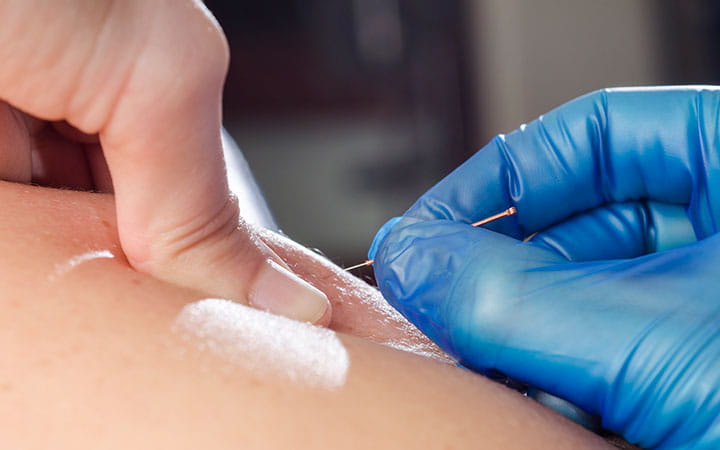In Pain? Why Dry Needling May Help
October 08, 2016

When you’re in pain, you know how hard it can be to find relief. One option might be dry needling, which for many, restores mobility and relieves muscle pain.
Dry needling, like acupuncture, uses thin, stainless steel needles that are inserted into the skin.
“Dry needling is a method of treatment that can eliminate pain, reduce muscle tension and increase range of motion,” says certified strength and conditioning specialist Brian Magat, DPT, ATC, MS, CSCS.
“Dry needling involves a ‘dry’ needle – one without medication or injection," he says. "The needle is inserted through the skin into areas of the muscle, known as trigger points, to help manage acute or chronic pain and to eliminate muscle dysfunction and improve muscle function.”
When your body is in pain and injured from repetitive use or acute trauma, your muscles become inflamed and overstimulated, Mr. Magat says.
Here are six commonly asked questions about dry needling:
How is Dry Needling Different Than Acupuncture?
Dry needling uses sterile needles similar in size to the needles used for acupuncture, but unlike acupuncture, dry needling isn’t a traditional Chinese medicine technique, Mr. Magat says. Dry needling is based on Western medical science, anatomy and neurophysiology.
“Instead of inserting needles into the ‘energetic pathways’ defined by traditional Chinese medicine, specially licensed dry needle practitioners like myself insert them directly into the muscle’s trigger points and the nerve pathways that are causing the pain,” he says. “Also, while acupuncture needles remain close to the skin’s surface, dry needling pushes them farther into the muscle or tendons and, thus, requires an intricate understanding of anatomy.”
What Are Trigger Points?
“Trigger points are like hard knots or tight bands in the muscle and connective tissue called fascia that may cause pain over a large area,” Mr. Magat says. “This makes it difficult to perform everyday tasks or engage in athletic competition.”
When Mr. Magat inserts a dry needle into a trigger point, it causes a change in chemistry inside the muscle, which sparks the healing phase.
“By deactivating the trigger point, we reset the muscle,” he says. “This restores the muscle’s homeostasis and balance, which leads to decreased pain and improved function and muscle integrity.”
What Conditions Does Dry Needling Treat?
Dry needling can help anyone who is experiencing pain, helping your body return to its natural, healthy and fully functioning state, he says. Dry needling is particularly effective for conditions such as:
- Hamstring problems
- Soft tissue injuries
- Carpal tunnel syndrome
- Neck and back pain
- Tendinitis and/or bursitis
- Muscle spasms and strains
- Sciatic pain
- Tennis and golfer’s elbow
- Overuse injuries
- Acute/chronic injuries
- Headaches
Does Dry Needling Hurt?
“Dry needling is relatively painless,” he says. “The amount of pain varies for different people and their trigger points. Generally, it’s not worse than a bee sting or a mild cramp and goes away quickly.”
Is Dry Needling Safe?
Dry needling is a drug-free, safe and effective treatment option for most patients. However, anyone with a needle phobia, metal allergy, vascular disease and/or abnormal bleeding tendency should discuss this with their physical therapist before having the dry needling procedure done.
How Many Dry Needling Treatments Are Needed?
It usually takes between two to four treatment sessions before you experience improved range of motion and joint use and reduction in pain, Magat says. Typically, he recommends that patients see him once or twice a week for a minimum of four sessions, depending on the severity of their condition.
Brian Magat, DPT, ATC, MS, CSCS, is a physical therapist at University Hospitals Rehabilitation Services. You can request an appointment with Magat or any other University Hospitals healthcare provider online.
Tags: Pain, Integrative Medicine


